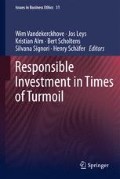Abstract
This article is not about me. Nonetheless, a brief personal introduction will put my argument in context: From 2005 until 2008 I worked for Norges Bank Investment Management (NBIM), for most of this time as their Head of Corporate Governance; indeed, the first one to have that title, since this was a new department within the bank. The term Corporate Governance was used to denote the bank’s work on active ownership, meaning involvement through voting and engagement with companies in the bank’s equity portfolio.1
Access this chapter
Tax calculation will be finalised at checkout
Purchases are for personal use only
Notes
- 1.
The views presented in this article are purely my own and should not in any way be taken to represent the views or opinions of NBIM or the Norwegian Government Pension Fund – Global.
- 2.
The fund is customarily referred to as the second-biggest worldwide in the category of Sovereign Wealth Funds, with assets under management totaling more than US$ 500 bn. as of November 2010. For articles covering sovereign wealth funds, including the Norwegian fund, see http://www.ft.com/indepth/sovereignfunds.
- 3.
For the fund’s ethical guidelines, see http://www.regjeringen.no/en/dep/fin/Selected-topics/the-government-pension-fund/responsible-investments/the-ethical-guidelines.html?id=434894.
- 4.
See www.unpri.org.
- 5.
By ‘motivation’ I mean what drives a person to do something. By ‘intention’ and ‘aim’ I mean the end result aimed at, although ‘intention’ can also be used in a sense closer to the state of mind of the actor, which often underlies the expression ‘acting with a good (or a bad) intention’. Michael Bratman defines ‘intention’ as ‘conduct-controlling’ attitudes, or – as he puts it – ‘pro-attitudes’, i.e., attitudes that say something about what I want, judge desirable, care about, etc. (Bratman 1987: 6, 15). This comes close to the way in which I use ‘motivation’ here.
- 6.
As one of the book’s editors has perceptively pointed out during the review process, such examples can be misleading, since they most clearly apply to intuitions related to the sort of situation described – in this case, the choice of restaurant. And obviously, choosing a restaurant does not equate with, nor truly resemble, investing. My point, however, is to tease out a general point about the thoughts and actions of human beings, namely, the relationship between primary and secondary motivations, and as such I believe the example works well. It may even be more useful to utilize an example from another walk of life than one related to the topic mainly under consideration, in order to avoid an issue-specific discussion of some particular point within (in our case) responsible investment.
- 7.
And I am not here claiming that short-termism or greed in financial companies alone produced the financial crisis; clearly, systemic factors, not least related to trade and debt imbalances, contributed heavily to the gravity of the crisis.
References
Bratman, Michael E. 1987. Intentions, Plans, and Practical Reason. Cambridge, MA: Harvard University Press.
Bugg-Levine, Antony. 2009. Impact investing: Harnessing capital markets to drive development at scale. Beyond Profit 1 May/June 2009: 17-21.
Gjessing, Ola Peter, and Henrik Syse. 2007. Norwegian petroleum wealth and universal ownership. Corporate Governance 15: 427-437.
Monks, Robert A. G. 2001. The New Global Investors. Oxford: Capstone.
Sullivan, Rory and Craig Mackenzie. 2006. Shareholder Activism on Social, Ethical and Environmental Issues. In Responsible Investment, eds. Rory Sullivan and Craig Mackenzie, 150-157. Sheffield: Greenleaf.
Syse, Henrik. 2008. Investments, universal ownership, and public health. In International Public Health Policy and Ethics, ed. Michael Boylan, 175-188. Dordrecht: Springer.
Thamotheram, Raj and Helen Wildsmith. 2006. Putting the Universal Owner Hypothesis into Action: Why Large Retirement Funds Should Want to Collectively Increase Overall Market Returns and What They Can Do about It. Delegate Handbook Corporate Governance & Responsible Investment. May 31, 2006, Stockholm. Available at: http://www.rotman.utoronto.ca/icpm/files/Putting%20the%20Universal%20Owner%20Hypothesis%20into%20Action_ Raj%20Thamotheram%20and%20Helen%20Wildsmith.pdf. Accessed April 2010.
Author information
Authors and Affiliations
Corresponding author
Editor information
Editors and Affiliations
Rights and permissions
Copyright information
© 2012 Springer Science+Business Media B.V.
About this chapter
Cite this chapter
Syse, H. (2012). Why Responsible Investing?. In: Vandekerckhove, W., Leys, J., Alm, K., Scholtens, B., Signori, S., Schäfer, H. (eds) Responsible Investment in Times of Turmoil. Issues in Business Ethics, vol 31. Springer, Dordrecht. https://doi.org/10.1007/978-90-481-9319-6_13
Download citation
DOI: https://doi.org/10.1007/978-90-481-9319-6_13
Publisher Name: Springer, Dordrecht
Print ISBN: 978-94-007-4070-9
Online ISBN: 978-90-481-9319-6
eBook Packages: Business and EconomicsEconomics and Finance (R0)

